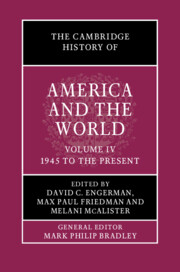Book contents
- The Cambridge History of America and the World
- The Cambridge History of America and the World
- The Cambridge History of America and the World
- Copyright page
- Contents
- Figures
- Maps
- Contributors to Volume IV
- General Introduction: What is America and the World?
- Introduction to Volume IV
- Part I Ordering a World of States
- Part II Challenging a World of States
- 10 US Foreign Policy and the End of Development
- 11 Oil and American Insecurity
- 12 US Mass Culture and Consumption in a Global Context
- 13 Imperial Visions of the World
- 14 Human Rights
- 15 Compassion and Humanitarianism in International Relations
- 16 Third World Internationalism and the Global Color Line
- 17 The Queering of US Geopolitics
- 18 Migration, War, and the Transformation of the US Population
- 19 Christian and Muslim Transnational Networks
- 20 Native Americans, Indigeneity, and US Foreign Policy
- 21 Environment, Climate, and Global Disorder
- 22 Détente and the Reconfiguration of Superpower Relations
- Part III New World Disorder?
- Index
15 - Compassion and Humanitarianism in International Relations
from Part II - Challenging a World of States
Published online by Cambridge University Press: 12 November 2021
- The Cambridge History of America and the World
- The Cambridge History of America and the World
- The Cambridge History of America and the World
- Copyright page
- Contents
- Figures
- Maps
- Contributors to Volume IV
- General Introduction: What is America and the World?
- Introduction to Volume IV
- Part I Ordering a World of States
- Part II Challenging a World of States
- 10 US Foreign Policy and the End of Development
- 11 Oil and American Insecurity
- 12 US Mass Culture and Consumption in a Global Context
- 13 Imperial Visions of the World
- 14 Human Rights
- 15 Compassion and Humanitarianism in International Relations
- 16 Third World Internationalism and the Global Color Line
- 17 The Queering of US Geopolitics
- 18 Migration, War, and the Transformation of the US Population
- 19 Christian and Muslim Transnational Networks
- 20 Native Americans, Indigeneity, and US Foreign Policy
- 21 Environment, Climate, and Global Disorder
- 22 Détente and the Reconfiguration of Superpower Relations
- Part III New World Disorder?
- Index
Summary
The decades since World War II have been characterized by distinct patterns of conflict and cooperation between US foreign policy and humanitarian organizations. This is, in many ways, predictable given their goals and what each wants from the other. American humanitarian organizations pledge a commitment to the idea of saving distant strangers in urgent, life-threatening circumstances. And just like all humanitarian organizations, they need two fundamental things to do so. Money, and lots of it. Assembling, transporting, distributing, administering, and overseeing the massive amounts of aid requires considerable money, material, and staff. They also need access to the affected populations. This access is mainly controlled by states and armed groups. In natural disasters this tends to be a minor challenge; governments and affected populations typically welcome any and all aid. Human-made disasters such as war, though, are an entirely different matter. Delivering aid in war zones is much less straightforward.
- Type
- Chapter
- Information
- The Cambridge History of America and the World , pp. 349 - 369Publisher: Cambridge University PressPrint publication year: 2022

